Abstract
Recently, the metalens has been investigated for its application in many fields due to its advantages of being much smaller than a conventional lens and is compatible with nano-devices. Although metalenses have extraordinary optical performance, it is still not enough in some occasions such as wavefront detection for adaptive optics and display for large area applications. Using a metalens array is an ideal solution to solve these problems. Unfortunately, the common metalens array cannot be adjusted once it is fabricated, which limits its range of application. In this article, we designed an actively tunable metalens array for the first time by arranging the patterned phase change material Ge2Sb2Te5 (GST) appropriately. For the metalens array designed at the wavelength of 4.6 μm, it had excellent broadband performance in the range from 4.5 μm to 5.2 μm. On the other hand, by tuning the phase state of GST, the focus and display of the metalens array can be controlled, acting as switching on or off. Furthermore, any graphics constructed with patterned focal spots can be achieved when the metalens array has sufficient secondary unit cells. The proposed metalens may have potential application value in the adaptive optics and dynamic display field.
1. Introduction
For conventional convex lens, its surface needs to be shaped to satisfy the following hyperbolodial phase profile:
where (x, y) is the coordinate of exit surface in lens; λ is the incident wavelength; and f is the focal length. The phase distribution is accomplished by optical path accumulation in the conventional lens, so it cannot have a thin and small size due to the limited refractive index of materials and processing technology. These limitations result in the fact that conventional lens no longer meet the requirement of modern nano-devices. Metasurfaces, a kind of novel 2-D metamaterial with the ability to flexibly manipulate the amplitude, phase, and polarization of light by adjusting the size or orientation of resonators [1,2,3,4], has been applied in many fields such as optical computing, beam steering, imaging, cloaking, hologram, and so on [5,6,7,8,9,10,11,12,13,14]. As one of the most practicable appliances of metasurfaces, the metalens has been designed to solve the problems of integration with modern nano-devices. Compared with conventional lens, metalens possess a smaller size due to a meta-unit induced abrupt phase shift for its phase distribution. Recently, many researchers have been dedicated to improving the optical performance of metalens, for example, focusing several discrete wavelengths at the same position [15,16]; achromatic focusing at a continuous broadband [17,18]; multi-focus for different wavelengths or polarized light [19,20]; and tunable ability utilizing stretchable materials, liquid metal, or phase change materials [20,21,22,23]. All of these contributions have explored an exciting field to replace conventional lens with metalens to obtain better optical performance and higher integration. Nevertheless, for some special appliances such as wavefront detection and display in adaptive optics, a single metalens is not enough anymore.
The idea of a metalens array provides a new way to combine novel metalens with conventional optical technology. For instance, a microlens array is used as the wavefront splitting element to focus the incident light of every sub-aperture in adaptive optics, therefore the wavefront is detected by the offset of the focused position [24]. The metalens array is constructed by a large number of well-arranged functional metalenses that can also focus the incident light separately. Compared with a conventional microlens array, the metalens array is much smaller, which fits the trend of miniature devices. In addition, the metalens exhibits higher imaging resolution, corresponding to a higher detection accuracy. The great potential of a metalens array has gradually attracted the attention of researchers. Lately, Qiu Wang et al. experimentally examined and explored a flat-lens array at a terahertz range based on C-shape split-ring resonators (CSRRs) [25]; and Zhenyu Yang et al. proposed a Hartmann-Shack metalens array based on transmissive dielectric silicon [26]. However, once these metalens arrays have been fabricated, their functions cannot be engineered, which has limited their practical application.
The development of using phase change materials might be an ideal approach to solve the above-mentioned problems. As a typical phase change material, Ge2Sb2Te5 (GST) is used for optical disk media at the beginning [27,28,29]. It has two different phase states including an amorphous state and a crystalline state. With appropriate thermal, electrical, or optical stimulus, the phase state of GST can be easily tuned [27,28,29]. When the GST is tuned between two states, the corresponding permittivity will be changed simultaneously, which can be used to realize active control. Due to its remarkable tuning abilities such as high stability and fast switch speed [29,30], GST has been applied in many novel tunable nano-photonic devices such as multi-wavelength duplex metalens, dipole-quadrupole (DQ) Fano resonance (FR) induced lateral force, beam steering, filter, color control, and ultraviolet/high-energy-visible resonances by combining with metasurfaces [20,31,32,33,34,35,36], which has proved to be the great potential of GST. Nevertheless, the research for tunable metalens array using phase change materials has not been explored yet.
In this article, we designed an actively tunable metalens array at the mid-infrared (M-IR) wavelength based on patterned phase change material GST. Although many tunable nano-devices have been achieved by phase change materials, they use phase change materials as a dielectric layer, where the multi-layer design method increases the complexity of the system. Here, our proposed tunable metalens array is a single layer device directly constructed of patterned GST to make our devices go further in the way of the miniaturization of the systems. Benefiting from the Pancharatnam-Berry (P-B) phase shift, the metalens array has excellent broadband performance in the range from 4.5 μm to 5.2 μm. By changing the phase state of GST settled in different sections, the performance of the tunable metalens array can be actively controlled at the designed wavelength of 4.6 μm. Completely switching on and off, focused letters, and symbols “L”, “H”, “+” and “−” will be demonstrated in the article. We believe our efforts will make some contributions to the application of tunable metalens arrays.
2. Materials and Methods
In the design process, the P-B phase shift was adopted to generate the abrupt phase. The amplitude and phase were related to the materials to construct the unit cell. As introduced above, the permittivity of GST will be changed greatly when its state is tuned between the amorphous state and crystalline state. Therefore, the patterned GST can be used directly to construct as the tunable meta-atoms instead of using it as a dielectric layer. This design method has decreased the complexity of the device further, making it more suitable for the integration of nano-devices. The structure arrangement diagram of the unit cell is shown in Figure 1a. The green blocks represent the patterned GST. Figure 1b shows one of the unit cells. The patterned GST is settled on the substrate SiO2, and a thin indium tin oxide (ITO) layer, sandwiched between the substrate and GST, is used as an electrical heating layer to tune the phase state of GST. Figure 1c is the top view of the unit cell. The patterned GST forms an angle θ with the x axis, which can be used to generate an abrupt phase. When a left/right circularly polarization (LCP/RCP) incident light propagates along the +z direction, the output light field can be simply expressed as:
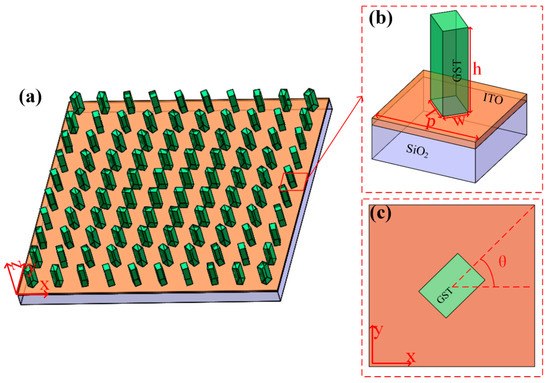
Figure 1.
(a) Structure arrangement diagram of the unit cell. (b) The overview of the unit cell. The patterned Ge2Sb2Te5 (GST) is settled on the substrate, and a 20 nm thin indium tin oxide (ITO) conductive layer is sandwiched between the GST and substrate. The structure parameters are p = 3 μm, l = 1 μm, w = 0.7 μm, and h = 2.5 μm. (c) The top view of the unit cell. The patterned GST forms an angle θ with the x axis.
Here, “” is used to distinguish the polarization of the light, and the normalized coefficient is neglected. α is the propagation constant that can be expressed as , where and represent the complex transmission coefficients along the optical fast axis and slow axis, which is determined by the parameters of the unit cell (p, l, w, h, ε(ω))(“+” for cross-polarization and “-” for co-polarization). According to Equation (2), the incident light EL/R is divided into two cross polarized lights after passing through the unit cell. The same polarized light only has the amplitude modulation. The cross polarized light not only has the amplitude modulation, but also has the phase modulation of 2θ. When the angle θ is changed from 0 to π, the corresponding phase modulation can cover the whole range from 0 to 2π theoretically, which is sufficient for the metalens array.
However, the parameters of the unit cell need to be designed carefully to satisfy the tuning function. When the patterned GST is in an amorphous state, the conversion efficiency from LCP to RCP should be high enough and the phase modulation should strictly satisfy the linear relationship of . When the patterned GST is in a crystalline state, the conversion efficiency from LCP to RCP should be low enough. Due to the low conversion efficiency, the corresponding phase modulation relations can be ignored. The simulation of the unit cell was performed using the finite-element method in the frequency domain with the unit cell boundary in the xy direction and the open boundary in the z direction. In the simulation, the incident LCP was settled propagating along the +z direction through the substrate. The GST data were obtained from the experimental data in [37], where the dielectric function ε(ω) was investigated by infrared spectroscopy and spectroscopic ellipsometry. The big differences of ε(ω) between amorphous GST and crystalline GST at the wavelength of 4~5.4 μm are shown in Figure 2. Considering that the parameters p, l, w, and h are designed to determine the conversion efficiency, we needed to sweep the parameters, picking up the parameters where the conversion efficiency was high enough. Due to the four freedom, the data are complicated. Here, only the conversion efficiency versus l and w is depicted in Figure 3a, when p was fixed as 3 μm and h is fixed as 2.5 μm. Finally, the parameters of the unit cell were determined as p = 3 μm, l = 1 μm, w = 0.7 μm, and h = 2.5 μm. Figure 3b shows the relationship between the conversion efficiency from LCP to RCP and wavelength when GST is in amorphous state and crystalline state. The conversion efficiency exceeded 75% in the whole range from 4.5 μm to 5.2 μm when GST was in an amorphous state, while it was less than 10% for crystalline GST. At the designed wavelength of 4.6 μm, when the angle changed from 0 to π, the phase modulation of the unit cell for both GST states are shown in Figure 3c. While the GST was in an amorphous state, the abrupt phase covered the whole 2π range linearly. Figure 3d shows the relationship between the conversion efficiency and rotating angle θ. When the conversion efficiency for amorphous GST was as high as 89.1%, while the conversion efficiency for crystalline GST was only 9.2%. When the angle changed from 0 to π, the conversion efficiency hardly changed for both GST states, which proves the high stability of the unit cell. In contrast, the co-polarization efficiency was considerably high (94%) when GST was in a crystalline state, while the co-polarization efficiency was only 14% for the amorphous state, as shown in Figure 3e. Figure 3f proves that the co-polarization light does have any phase modulation, as the theory predicted. This means that the incident light can pass through the unit cell just like passing through a transparent dielectric when GST is in a crystalline state. All the simulation results showed that the designed unit cell can very well meet the requirements of tunable function.

Figure 2.
(a) The real part of permittivity for amorphous GST and crystalline GST. (b) The imaginary part of permittivity for amorphous GST and crystalline GST.
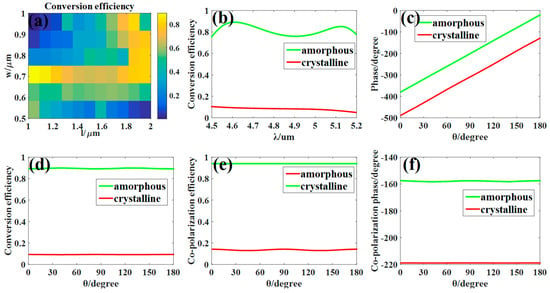
Figure 3.
(a) Conversion efficiency versus l and w when p = 3 μm and h = 2.5 μm. (b) The relationship between conversion efficiency and wavelength when GST stays in an amorphous state (green line) and crystalline state (red line). (c) The relationship between phase modulation and rotating angle θ. The phase modulation linearly covers the whole 2π range when the angle rotates from 0 to 180 degrees. (d) The relationship between conversion efficiency and rotating angle θ. (e) The relationship between co-polarization efficiency and rotating angle θ. (f) The relationship between co-polarization phase and rotating angle θ.
Then, the designed unit cell needs to be arranged appropriately to satisfy the hyperbolodial phase profile Equation (1) with . In our design, the radius of the single metalens was 30 μm, and the focal length was 60 μm with the numerical aperture (NA) of 0.45. Next, a single metalens was considered as the secondary unit cell to compose the metalens array. For simplicity, a 3 3 tunable metalens array was designed as shown in Figure 4. The green blocks represent the amorphous state GST, which can convert the incident LCP light into RCP light, then focus it at the focal plane. The red blocks represent the crystalline state GST, which could hardly convert the polarization of the incident light, thus no light was focused at this area. The proposed structure can be fabricated using electron beam lithography (EBL) and atomic layer deposition (ALD) methods. The combination of two methods can ensure that the structure has better conformality. The ITO layer can be sputtered on the substrate. As a thin film of transparent electrode, it has sufficient conductivity to allow the electrical Joule heating of the GST, so the state of the GST can be changed reversibly by applying an appropriate electrical current pulse (equivalent to ~0.3 V) [29] through the conductive layer; at the same time, it has little influence on the phase modulation. On the other hand, a high-repetition-rate femtosecond laser is also a good choice to switch the proposed device [23].
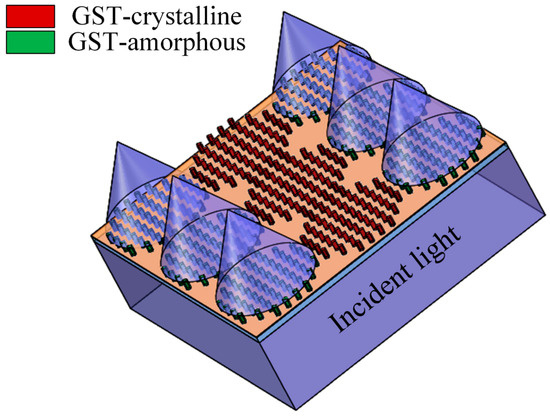
Figure 4.
The diagram of the tunable metalens array. The green blocks represent amorphous GST, which can focus the incident light, and the red blocks represent crystalline GST, which cannot focus the incident light. By actively tuning the phase state of GST, the performance of the metalens array can be controlled.
3. Results
The results of the metalens array was simulated by using the finite integration method in the time domain and the open boundary condition was adopted for all directions, while the minimum size of the mesh was set as 40 nm to minimize numerical errors. The incident light was the 4.6 μm LCP plane wave in the simulation. First, when all of the GST were in an amorphous state, the incident LCP light was converted into the RCP light and focused at the focal plane. Figure 5a shows the light field distribution of the metalens array in the xz plane. Viewed from this section, the focal length of the metalens array was 62.4 μm. The result had a slight deviation from the designed 60 μm because of the discontinuous phase distribution. However, the depth of focus was fairly large, which will have great advantages in many fields such as microscopy, endoscopy, detection cameras, and so on. Figure 6a shows the normalized intensity along the z direction when x = y = 0, exhibiting its great application potential in large focal depth optical systems. Figure 5c shows the light field distribution of the metalens array in the xy plane at the position of z = 62.4 μm. A 3 3 focal spot distribution was very clear in the focal plane. Each focal spot was located at the center of each area with the same intensity. The focusing efficiency for the metalens array was 80.2%, which is considerably high for a transmissive metalens array. Here, the focusing efficiency was defined as the ratio of light intensity of the focal plane to the incident plane. Figure 6b shows the normalized intensity of the metalens array in the x direction while y = 0. The full width at half maximum (FWHM) of the spot in the focal plane was 4.60 μm. The FWHM was less than , indicating that the resolution of the metalens array has gone beyond the resolution limit of a conventional lens, and has great potential in the high resolution imaging and detection field. In addition, the metalens array can also be employed as a transparent dielectric by applying a voltage to the ITO conductive layer to transfer the phase state of GST into the crystalline state. In this case, the incident LCP will pass through the metalens array where only a very small part of the light is converted into RCP light, thus little light is focused behind the metalens array, as shown in Figure 5b,d. The simulation results prove that the performance of the proposed actively tunable metalens array can be easily controlled and used more flexibly in some occasions.
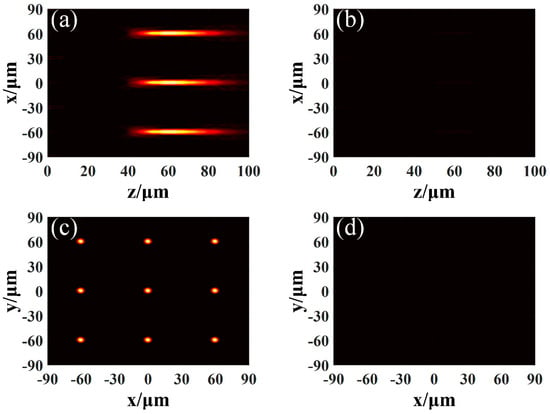
Figure 5.
(a,b) The light field in the xz plane for the metalens array when all GST are in an amorphous state and crystalline state. (c,d) The light field in the xy plane for the metalens array when all GST are in amorphous and crystalline states.
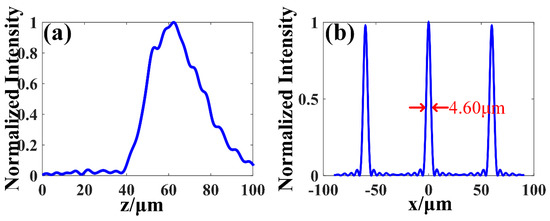
Figure 6.
(a) The normalized intensity of the light field along the z axis when x = y = 0 for amorphous GST. (b) The normalized intensity of the light field along the x axis at the focal plane when y = 0. The FWHM is 4.60 μm.
It is clear that one of the advantages of designing with the P-B phase shift is that it has a broadband response. Figure 7a shows the abrupt phase as a function of wavelength and rotating angle when GST is in the amorphous state. The results prove that the abrupt phase can still linearly cover the 2π range in the whole wavelength range from 4.5 μm to 5.2 μm. Figure 7b shows the phase variance with wavelength and angle when GST is in the crystalline state. At the same time, big differences in the conversion efficiency between the amorphous state and crystalline state still exist, as shown in Figure 7c (amorphous state) and Figure 7d (crystalline state), which proves that the tuning ability of the metalens array remains functional. For instance, when the incident lights were 4.5 μm, 4.85 μm, and 5.2 μm, the light fields of the metalens array in the xz plane are shown in Figure 8a,c,e. It is clear that the metalens array focused the three wavelengths of light, although it was designed at the wavelength of 4.6 μm. The focal length for the three wavelengths were 63.2 μm, 58.2 μm, and 53.6 μm separately, and it is reasonable that the focal length decreases with increasing wavelength, according to Equation (1). The light fields in the focal plane and the normalized intensity along the x axis for the three wavelengths are shown in Figure 8b,d,f. The FWHM of the spots in the focal plane were 4.50 μm, 4.80 μm, and 4.90 μm, respectively, indicating that all of them break through the resolution limit for a conventional lens. Similar effects can be observed across the whole range while the focusing efficiency stayed above 50%, which proves the excellent broadband focusing performance of the designed metalens array.
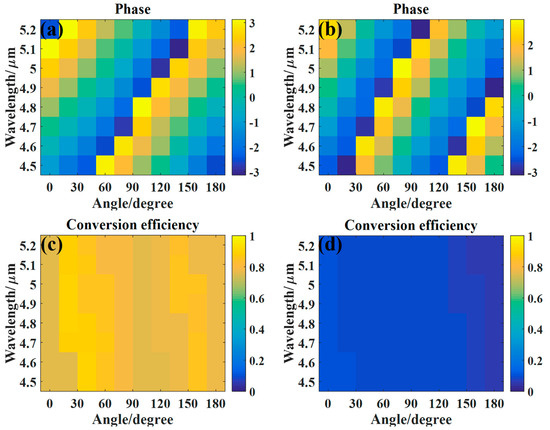
Figure 7.
(a,b) The abrupt phase variances with the wavelength and rotating angle when GST is in the amorphous state or crystalline state. (c,d) The conversion efficiency versus wavelength and rotating angle when GST is in the amorphous state or crystalline state.
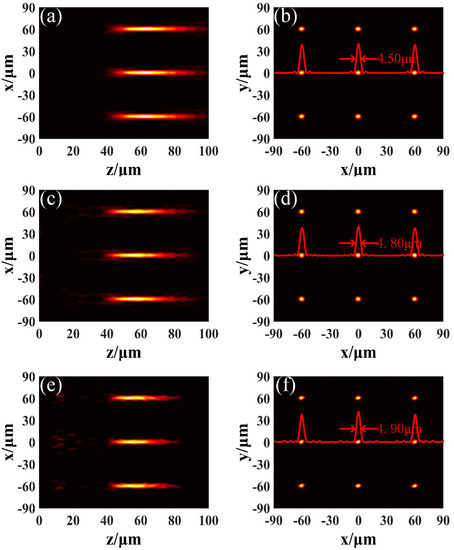
Figure 8.
(a,b) The broadband performance of the designed metalens array. The light field in the xz plane and xy plane when the incident light was 4.5 μm. (c,d) The light field in the xz plane and xy plane when the incident light was 4.85 μm. (e,f) The light field in the xz plane and xy plane when the incident light was 5.2 μm.
However, the proposed actively tunable metalens array not only acts as the focusing metalens array or transparent dielectric, but also contributes in the dynamic display area. The switching speed for GST is very fast (nanosecond or less) when the electrical or optical tuning method is adopted [29]. By controlling the phase state of GST instantaneously, any spot distributions can be obtained. Figure 9a–d show the focused graphics of letters and symbols “H”, “L”, “+” and “−” with the same metalens array. When the metalens array is large enough with N N unit cells, more complicated graphics can be formed in the focal plane. Benefitting from the ultrafast switching speed of GST and high resolution of the metalens, the proposed actively tunable metalens array may have great application potential in the dynamic display field.
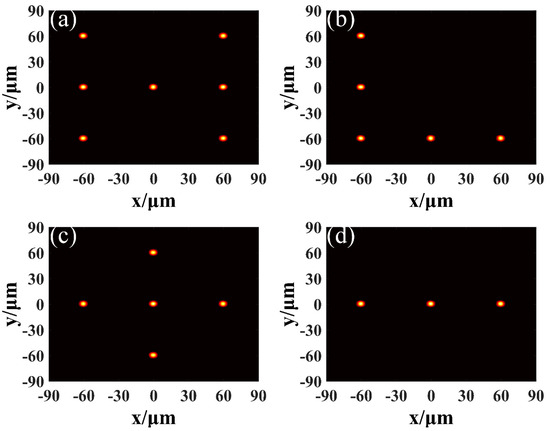
Figure 9.
By actively tuning the same metalens array, different graphics are shown in the focal plane as (a) “H”, (b) “L”, (c) “+”, and (d) “−”.
4. Conclusions
Phase change material GST is commonly used in tunable nano-photonic devices as a dielectric layer. In this article, patterned GST was directly used as the resonators of metasufaces, which makes the devices thinner and more flexible. When GST is in an amorphous state, the designed unit cell can convert incident light into the cross polarized light with phase modulation. When GST is in the crystalline state, the unit cell just passes through the incident light without polarization conversion and phase modulation. First, the unit cells were arranged appropriately to construct the metalens according to the phase profile; then using the metalens as the secondary unit cell, a 3 3 metalens array was designed. By tuning the phase state of GST, the tunable metalens array can be actively switched on or off, acting as a metalens array or transparent dielectric. Moreover, the designed metalens array has great focusing ability beyond the resolution limit of a conventional lens. Furthermore, the broadband performance of the metalens array was also confirmed. Additionally, the focal spots can form any graphics (“H”, “L”, “+” and “-” are shown in the article) by locally tuning the phase state of GST, and we believe that it has great potential in the dynamic display area.
Author Contributions
W.B. and J.Y. contributed to the idea. W.B., S.W., J.H., D.C., and J.Z. collected data for this manuscript. W.B. performed the numerical simulation and data analysis. P.Y., J.Y., and B.X. directed the project. All authors discussed the results and revised the manuscript.
Funding
This research was funded by the National Natural Science Foundation of China (grant numbers 60907003, 61671455, 61805251) and the Program for New Century Excellent Talents in University (grant number NCET-12-0142).
Conflicts of Interest
The authors declare no conflict of interest.
References
- Yu, N.; Genevet, P.; Kats, M.A.; Aieta, F.; Tetienne, J.; Capasso, F.; Gaburro, Z. Light propagation with phase discontinuities: Generalized laws of reflection and refraction. Science 2011, 334, 333–337. [Google Scholar] [CrossRef] [PubMed]
- Kildishev, A.V.; Boltasseva, A.; Shalaev, V.M. Planar photonics with metasurfaces. Science 2013, 339, 1232009. [Google Scholar] [CrossRef] [PubMed]
- Zheludev, N.I.; Kivshar, Y.S. From metamaterials to metadevices. Nat. Mater. 2012, 11, 917. [Google Scholar] [CrossRef] [PubMed]
- Holloway, C.L.; Kuester, E.F.; Gordon, J.A.; O’Hara, J.; Booth, J.; Smith, D.R. An overview of the theory and applications of metasurfaces: The two-dimensional equivalents of metamaterials. IEEE Antennas Propag. Mag. 2012, 54, 10–35. [Google Scholar] [CrossRef]
- Chizari, A.; Abdollahramezani, S.; Jamali, M.V.; Salehi, J.A. Analog optical computing based on a dielectric meta-reflect array. Opt. Lett. 2016, 41, 3451–3454. [Google Scholar] [CrossRef]
- Abdollahazmezani, S.; Arik, K.; Khavasi, A.; Kavehvash, Z. Analog computing using graphene-based metalines. Opt. Lett. 2015, 40, 5239–5242. [Google Scholar] [CrossRef]
- Shalotout, A.; Liu, J.; Kildishev, A.; Shalaev, V. Photonic spin Hall effect in gap-plasmon metasurfaces for on-chip chiroptical spectroscopy. Optica 2015, 2, 860–863. [Google Scholar] [CrossRef]
- Sun, S.; Yang, K.; Wang, C.; Juan, T.; Chen, W.T.; Liao, C.Y.; He, Q.; Xiao, S.; Kung, W.; Guo, G.; et al. High-efficiency broadband anomalous reflection by gradient metasurfaces. Nano Lett. 2012, 12, 6223–6229. [Google Scholar] [CrossRef]
- Arbabi, A.; Arbabi, E.; Kamali, S.M.; Horie, Y.; Han, S.; Faraon, A. Miniature optical planar camera based on a wide-angle metasurface doublet corrected for monochromatic aberrations. Nat. Commun. 2016, 7, 13682. [Google Scholar] [CrossRef]
- Lee, G.; Hong, J.; Hwang, S.; Moon, S.; Kang, H.; Jeon, S.; Kim, H.; Jeong, J.; Lee, B. Metasurface eyepiece for augmented reality. Nat. Commun. 2018, 9, 4562. [Google Scholar] [CrossRef]
- Yang, Y.; Jing, L.; Zheng, B.; Hao, R.; Yin, W.; Li, E.; Soukoulis, C.M.; Chen, H. Full-polarization 3D metasurface cloak with preserved amplitude and phase. Adv. Mater. 2016, 28, 6866–6871. [Google Scholar] [CrossRef] [PubMed]
- Cai, W.; Chettiar, U.K.; Kildishev, A.V.; Shalaev, V.M. Optical cloaking with matermaterials. Nat. Photonics 2017, 1, 224. [Google Scholar] [CrossRef]
- Chen, W.T.; Yang, K.; Wang, C.; Huang, Y.; Sun, G.; Chiang, I.; Liao, C.Y.; Hsu, W.; Lin, H.T.; Sun, S.; et al. High efficiency broadband meta-hologram with polarization controlled dual images. Nano Lett. 2013, 14, 225–230. [Google Scholar] [CrossRef] [PubMed]
- Huang, Y.; Chen, W.T.; Tsai, W.; Wu, P.C.; Wang, C.; Sun, G.; Tsai, D.P. Aluminum plasmonic multicolor meta-hologram. Nano Lett. 2015, 15, 3122–3127. [Google Scholar] [CrossRef] [PubMed]
- Arbabi, E.; Arbabi, A.; Kamali, S.M.; Horie, Y.; Faraon, A. High efficiency double-wavelength dielectric metasurface lenses with dichroic birefringent meta-atoms. Opt. Express 2016, 24, 18468–18477. [Google Scholar] [CrossRef] [PubMed]
- Arbabi, E.; Arbabi, A.; Kamali, S.M.; Horie, Y.; Faraon, A. Controlling the sign of chromatic dispersion in diffractive optics with dielectric metasurfaces. Optica 2017, 4, 625–632. [Google Scholar] [CrossRef]
- Khorasaninejad, M.; Shi, Z.; Zhu, A.Y.; Chen, W.T.; Sanjeev, V.; Zaidi, A.; Capasso, F. Achromatic metalens over 60 nm bandwidth in the visible and metalens with reverse chromatic dispersion. Nano Lett. 2017, 17, 1819–1824. [Google Scholar] [CrossRef]
- Chen, W.T.; Zhu, A.Y.; Sanjeev, V.; Khorasaninejad, M.; Shi, Z.; Lee, E.; Capasso, F. A broadband achromatic metalens for focusing and imaging in the visible. Nat. Nanotechnol. 2018, 13, 220. [Google Scholar] [CrossRef]
- Boroviks, S.; Deshpande, R.A.; Mortensen, N.A.; Bozhevolnyi, S.I. Multifunctional metamirror: Polarization splitting and focusing. ACS Photonics 2017, 5, 1648–1653. [Google Scholar] [CrossRef]
- Bai, W.; Yang, P.; Wang, S.; Huang, J.; Chen, D.; Zhang, Z.; Yang, J.; Xu, B. Tunable duplex metalens based on phase-change materials in communication range. Nanaomaterials 2019, 9, 993. [Google Scholar] [CrossRef]
- Kamali, S.M.; Arbabi, E.; Arbabi, A.; Horie, Y.; Faraon, A. Highly tunable elastic dielectric metasurface lenses. Laser Photonics Rev. 2016, 10, 1002–1008. [Google Scholar] [CrossRef]
- Zhu, W.; Song, Q.; Yan, L.; Zhang, W.; Wu, P.; Chin, L.K.; Cai, H.; Tsai, D.P.; Shen, Z.X.; Deng, T.W.; et al. A flat lens with tunable phase gradient by using random access reconfigurable metamaterial. Adv. Mater. 2015, 27, 4739–4743. [Google Scholar] [CrossRef] [PubMed]
- Wang, Q.; Rogers, E.T.F.; Gholipour, B.; Wang, C.; Yuan, G.; Teng, J.; Zheludev, N.I. Optically reconfigurable metasurfaces and photonic devices based on phase change materials. Nat. Photonics 2016, 10, 60. [Google Scholar] [CrossRef]
- Seifert, L.; Liesener, J.; Tiziani, H.J. The adaptive Shack-Hartmann sensor. Opt. Commun. 2003, 216, 313–319. [Google Scholar] [CrossRef]
- Wang, Q.; Zhang, X.; Xu, Y.; Tian, Z.; Gu, J.; Yue, W.; Zhang, S.; Han, J.; Zhang, W. A broadband metasurface-base terahertz flat-lens array. Adv. Opt. Mater. 2015, 3, 779–785. [Google Scholar] [CrossRef]
- Yang, Z.; Wang, Z.; Wang, Y.; Feng, X.; Zhao, M.; Wan, Z.; Zhu, L.; Liu, J.; Huang, Y.; Xia, J.; et al. Generalized Hartmann-Shack array of dielectric metalens sub-arrays for polarimetric beam profiling. Nat. Commun. 2018, 9, 4607. [Google Scholar] [CrossRef]
- Wuttig, M. Phase-change materials: Towards a universal memory? Nat. Mater. 2005, 4, 265. [Google Scholar] [CrossRef]
- Wuttig, M.; Yamada, N. Phase-change materials for rewriteable data storage. Nat. Mater. 2007, 6, 824. [Google Scholar] [CrossRef]
- Loke, D.; Lee, T.H.; Wang, W.J.; Shi, L.P.; Zhao, R.; Yeo, Y.C.; Chong, T.C.; Elliott, S.R. Breaking the speed limits of phase-change memory. Science 2012, 336, 1566–1569. [Google Scholar] [CrossRef]
- Kim, I.S.; Cho, S.L.; Im, D.H.; Cho, E.H.; Kim, D.H.; Oh, G.H.; Ahn, D.H.; Park, S.O.; Nam, S.W.; Moon, J.T.; et al. High performance PRAM cell scalable to sub-20nm technology with below 4F2 cell size extendable to DRAM applications. In Proceedings of the 2010 Symposium on VLSI Technology, Honolulu, HI, USA, 15–17 June 2010; pp. 203–204. [Google Scholar] [CrossRef]
- Cao, T.; Bao, J.; Mao, L.; Zhang, T.; Novitsky, A.; Nieto-Vesperinas, M.; Qiu, C. Controlling lateral Fano interference optical force with Au-Ge2Sb2Te5 hybrid nanostructure. Acs Photonics 2016, 3, 1934–1942. [Google Scholar] [CrossRef]
- Galarreta, C.R.D.; Alexeev, A.M.; Au, Y.; Lopez-Garcia, M.; Klemm, M.; Cryan, M.; Bertolotti, J.; Wright, C.D. Nonvolatile reconfigurable phase-change metadevices for beam steering in the near infrared. Adv. Funct. Mater. 2018, 28, 1704993. [Google Scholar] [CrossRef]
- Dong, W.; Qiu, Y.; Zhou, X.; Banas, A.; Banas, K.; Breese, M.B.H.; Cao, T.; Simpson, R.E. Tunable mid-infrared phase-change metasurface. Adv. Opt. Mater. 2018, 6, 1701346. [Google Scholar] [CrossRef]
- Karvounis, A.; Gholipour, B.; MacDonald, K.F.; Zheludev, N.I. All-dielectric phase-change reconfigurable metasurface. Appl. Phys. Lett. 2016, 109, 051103. [Google Scholar] [CrossRef]
- Gholipour, B.; Karvounis, A.; Yin, J.; Soci, C.; MacDonald, K.F.; Zheludev, N.I. Phase-change-driven dielectric-plasmonic transitions in chalcogenide metasurfaces. NPG Asia Mater. 2018, 10, 553. [Google Scholar] [CrossRef]
- Gholipour, B.; Piccinotti, D.; Karvounis, A.; MacDonald, K.F.; Zzheludev, N.I. Reconfigurable ultraviolet and high-energy visible dielectric metamaterials. Nano Lett. 2019, 19, 1643–1648. [Google Scholar] [CrossRef]
- Shportko, K.; Kremers, S.; Woda, M.; Lencer, D.; Robertson, J.; Wuttig, M. Resonant bonding in crystalline phase-change materials. Nat. Mater. 2008, 7, 653. [Google Scholar] [CrossRef]
© 2019 by the authors. Licensee MDPI, Basel, Switzerland. This article is an open access article distributed under the terms and conditions of the Creative Commons Attribution (CC BY) license (http://creativecommons.org/licenses/by/4.0/).